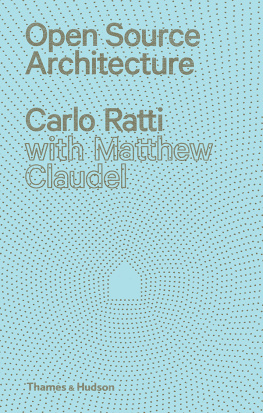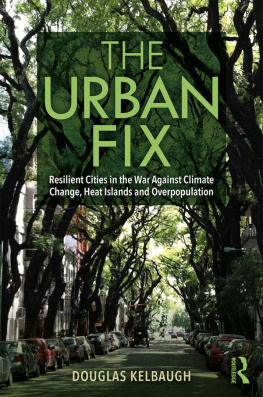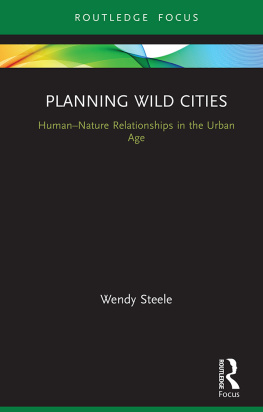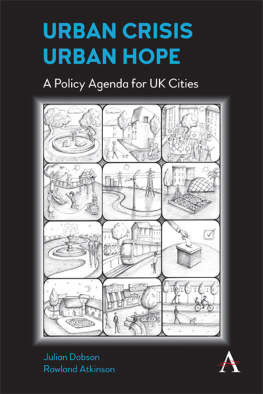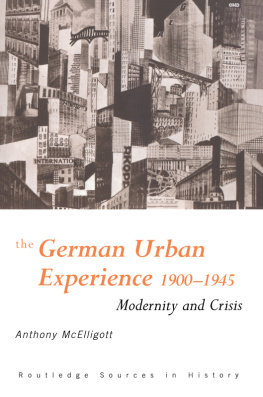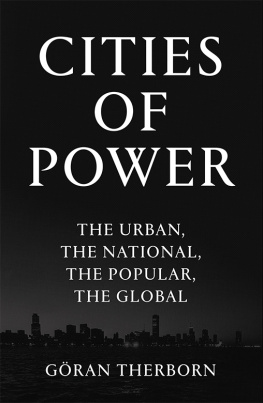THE CITY OF TOMORROW

SENSORS,
NETWORKS,
HACKERS,
THE CITY OF TOMORROW
AND THE
FUTURE OF
URBAN LIFE
CARLO RATTI AND
MATTHEW CLAUDEL

Copyright 2016 by Carlo Ratti and Matthew Claudel. All rights reserved. This book may not be reproduced, in whole or in part, including illustrations, in any form (beyond that copying permitted by Sections 107 and 108 of the U.S. Copyright Law and except by reviewers for the public press), without written permission from the publishers.
Yale University Press books may be purchased in quantity for educational, business, or promotional use. For information, please e-mail (U.K. office).
Designed by Nancy Ovedovitz and set in Scala and The Sans types by Integrated Publishing Solutions. Printed in the United States of America.
Library of Congress Control Number: 2015955547
ISBN 978-0-300-20480-3 (hardcover : alk. paper)
A catalogue record for this book is available from the British Library.
This paper meets the requirements of ANSI/NISO Z39.481992 (Permanence of Paper).
10 9 8 7 6 5 4 3 2 1
Frontispiece: New York Talk Exchange (detail; see )
CONTENTS
PART I THE CITY OF TOMORROW (AND TODAY)
We are called to be architects of
the future, not its victims.
R. Buckminster Fuller, 1969
ONE
FUTURECRAFT
On December 24, 1900, the Boston Globe ran a piece imagining what Boston would look like at the turn of the millennium. The lavishly illustrated article by Thomas F. Anderson painted an elaborate vision of a city with moving sidewalks, airships soaring high above the streets, and pneumatic tube delivery of everything from newspapers to food. The authors predictions were sweeping and optimistic: Boston would be so beautiful that the word slum would be eliminated from the citys vernacular.
Such descriptions, in retrospect, are almost comicalyet a hope of glimpsing the future continues to enchant us. A vibrant thread in fiction and film, speculations have become a genre in their own right, encompassing, as a common trope, the future of the city. Notions vary widely, from H. G. Wells grim dystopias to Fritz Langs Metropolis or the pseudopolice state of Minority Report. Regardless of the time and medium, however, nothing ever looks as dated as old science fiction, as the saying goes. Futures quickly become paleofuturesearly speculations about the futures that would never come to pass.
In the midst of a sprawling graveyard of ideas, an exercise like this bookan exploration of cities as part of Yale University Presss series on the futureis vexed with a crucial question: Is it possible for our predictions to escape the fate of Andersons? How can we avoid the scrap heap of urban visions? And, more specifically, Does the act of considering the futurein this case, the future of the cityhave inherent and productive value?
Traditionally, most future visions have been attempts to accurately depict the world of tomorrowand that may be their undoing. Prediction often involves assaying weak signals at the cutting edge of the contemporary world and flinging them far forward, for decades or centuries, to arrive at a portrait of the future city. To Anderson, writing in the year 1900, soon after the dazzling introduction of zeppelin travel and pneumatic technology, it seemed all but assured that these advances would define urban development over the course of the next hundred years. The state of the art stirred his imagination and defined his portrait of millennial Boston.
We propose something quite different: to employ design in a systematic exploration and germination of possible futures. Our aim is not to portray what is to come. Rather, we apply a method that we call futurecraft: we posit future scenarios (typically phrased as What if? questions), entertain their consequences and exigencies, and share the resulting ideas widely, to enable public conversation and debate. In other terms, we propose to extrapolate from the present condition and to place ourselves, as designers, in a fictive but possible future context with the intent of realizing or precluding that future through public discourse.
This concept, primarily developed through our research at the Massachusetts Institute of Technologys Senseable City Lab, has antecedents. Recently, Anthony Dunne and Fiona Raby at the Royal College of Art in London proposed speculative designa process that acts as a catalyst for collectively redefining our relationship to reality and considering how things could be. An earlier framework, Comprehensive Anticipatory Design Science (CADS) proposed by the iconic inventor Buckminster Fuller, uses a systematic approach to design that he developed through a class at MIT in 1956. Motivating Fuller in his work was a general belief that design, speculation, and science go hand in hand. The function of what I call design science is to solve problems by introducing into the environment new artifacts, the availability of which will induce their spontaneous employment by humans and thus, coincidentally, cause
Buckminster Fullers statement suggests a latent evolutionary concept. As technical culture progresses, objects are produced and iteratively refined through designan act that introduces mutations to improve a function or enable a new capability. On a broad scale, these mutations collectively promote change and development. In an 1863 text, Darwin among the Machines, the writer Samuel Butler proposed an evolutionary analogy for technology: replacing organisms with artifacts and classifying the synthetic kingdom into genera and species.
Variations of this concept have recurred both in theory and in practice. If we accept this evolutionary framework, a central question emerges: How can the designer accelerate positive technological change? To continue the biological analogy, could the crucial role of the designer be to produce anomalies (as new ideas)? The designer could become what, in biology, is referred to as a mutagenan agent of mutation. Although mutations in the natural world are random, our concept of design is directed by futurecraft.
Most importantly, futurecraft is not about fixing the present (an overwhelming task) or predicting the future (a disappointingly futile activity) but influencing it positively. Designers should not force their ideas into the worldin fact, whether or not an idea is realized is largely irrelevant. By virtue of being stated, explored, and debated, a concept will necessarily make an impact. Provocation is a better metric than certainty, for ideas both positive and negative. Effacing a dystopian vision for the sake of decency is a disservice, precluding the possibility of avoiding that future.

The Evolution of Culture by Augustus Henry Lane-Fox Pitt-Rivers
According to a long-standing hypothesis, the synthetic worldthe kingdom of human-made objectsevolves in a way that is analogous to biological evolution: by iterative generations, small mutations, and natural selection. In 1852, Augustus Henry Lane-Fox Pitt-Rivers, a British imperial officer and avid collector, was commissioned by the Crown to prepare a manual on firearms. In studying the history of weaponry, he became convinced of the gradual technical development of human artifacts over time. This image shows an arrangement of primitive weapons in his collection, which points to what he called the evolution of culture. He devoted his later life to evolutionary anthropology, testing the concept of synthetic evolution through his vast collection of artifacts. Although his assumptions are now regarded as contrived, the application of an evolutionary analogy to the synthetic world remains a useful interpretive tool.
Next page

